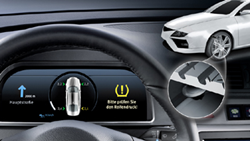Background information
Things you should know
 Pressure from the EU
Pressure from the EU
The new EU regulation is in place, and it helps improve safety and fuel efficiency while creating new service opportunities. Car manufacturers must already equip all new models in vehicle category M1 with tire pressure monitoring systems since 2012. And since November 1, 2014, the systems are mandatory for all newly registered vehicles in Europe.
Clear-cut rules
EU regulation ECE R 661 clearly specifies what safety information the system must display:
- It must report a sudden loss of pressure of 20% ore more within a period of ten minutes
- It must warn the driver if there is a gradual loss of pressure within 60 minutes
- It must function reliably at speeds of 40 km/h and more, up to the top design speed of the vehicle
Provided they meet the specification, automakers are free to decide what kind of system they wish to use in their vehicles. They have a choice between two very different technologies.
Indirect systems
These systems evaluate signals from a vehicle’s anti-lock brake (ABS) wheel speed sensors. A software component compares the speeds of the wheels. The speed of a wheel will increase if the tire has lower pressure due to the reduced rotational circumference. If the system detects a difference in wheel speeds and this is not attributable to the driving situation, a warning lamp on the instrument cluster will illuminate.
Direct systems
In a direct system each wheel/tire is equipped with a sensor that directly measures the tire pressure, and depending on the vehicle, may also measure temperature. This information is transmitted wirelessly to a control unit which analyses the data and displays a warning on the instrument cluster if low pressure is detected.
The main advantages at a glance
- Direct systems are faster and provide more precise data
- Direct systems have the potential to display the pressure and temperature of each tire individually, even when the vehicle is stationary
- Direct systems do not have to be recalibrated if the tire pressure changes due to an increase in load or a tire change (however direct systems do require a sensor/vehicle relearn when moving or replacing sensors – this may be automatic depending on the vehicle)
Go here to see our sensor service solutions for direct TPM Systems:
The versatile preprogrammed VDO REDI-Sensor
OE sensors
Small cause, big effect
The EU legislation was introduced for notable reasons. There are many cars on the road in Europe with insufficient tire pressure. Under-inflated tires not only cause increased fuel consumption and tire wear, they impair a vehicle’s handling characteristics and thus, create a safety risk.
There are good arguments for installing the new systems, as our educational video demonstrates:
